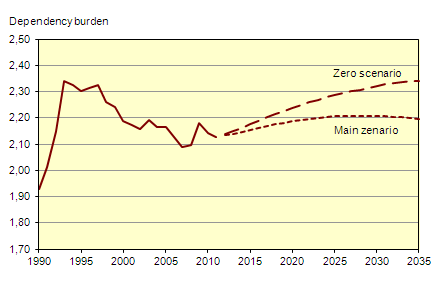Employment projection, development up to 2035 according to two scenarios:
Future employment of foreign born expected to increase
Statistical news from Statistics Sweden 2013-10-01 9.30
According to the main scenario in Statistics Sweden's employment projection, the number of employed persons is expected to increase by 490 000 persons and will amount to roughly 4.9 million persons in 2035. Foreign born persons account for the largest part of the increase.
The number of employed foreign born persons is expected to increase by about 390 000 persons by 2035, while the number of Swedish born will increase by 100 000. The reason that the increase in employment is greatest among foreign born persons is partly because the number of foreign born persons in the population is expected to increase in the future, and partly because of an assumption of higher employment rates among the foreign born. The main scenario also assumes that older people will work two years more than today, and that the proportion of Swedish born women who are employed will increase somewhat by 2035.
According to the zero scenario, when the proportion of employed persons is assumed to be unchanged from the 2011 level, the increase in the number of employed persons is expected to be more moderate. Future employment in the zero scenario is only affected by demographic development. In 2035 the employed population will amount to 4.64 million persons, which is 190 000 more than in 2011. The number of foreign born persons who are employed also increases in the zero scenario. However, employment decreases among Swedish born persons because the number of those persons in their most actively working ages is expected to decrease during the projection period.
The dependency burden increases according to both the main scenario and the zero scenario
The total population is expected to increase by about 1.4 million during the projection period by 2035. Most of the increase consists of persons who are age 65 or older, which can have considerable consequences for the future dependency burden. In 2011 the dependency burden was 2.13, which means that each employed person must "support" 2.13 persons including him/herself. In the zero scenario the dependency burden is expected to increase by 10 percent and amount to 2.34 in 2035. This is the same level that was measured during the economic downturn in the beginning of the 1990s. For the dependency burden to develop more slowly, the percentage of employed persons must increase in the future. If the percentage of those who are employed increases according to the main scenario, the dependency burden will be 2.20 in 2035, which corresponds to an increase of roughly 3 percent.

Source: Forecast Institute, Statistics Sweden Note: Time series breaks in 1993 and 2004
Definitions and explanations
- Statistics Sweden's latest population projection from April 2013 forms the basis for the projection.
- The results for 2035 are thoroughly compared with 2011 as the base year. The model is based on the development up to 2035 without any fluctuations in the business cycle. Thus, the results show the average development during the projection period.
- The dependency burden is defined as the total population divided by the number of employed persons aged 16-74
Publication
A more detailed report of this survey is published in Employment Projection 2013.
Feel free to use the facts from this statistical news but remember to state Source: Statistics Sweden.
